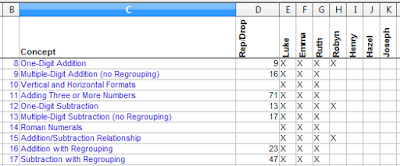Math on the Level (MotL) is a complete pre-K through pre-algebra math program developed by a homeschool mom. Instead of thinking of math in grade levels, she lists all of the topics that a student would need to cover through eighth grade (or in order to be ready for algebra). The topics are organized into four categories - Operations, Geometry & Measurement, Fractions and Money & Decimals. Within a category, the topics are organized approximately by complexity. You, as the mom, can choose which topic you'd like to teach next. There is no set minimum or maximum to cover each year. You teach what your child is developmentally ready to explore. She recommends that you cover topics from each of the four core books each year.
The MotL curriculum packs come with a book called "Math Resources" which demonstrates use of graphs and other visuals and a book called "Math Adventures" which is loaded with ideas for learning math through everyday activities like cooking, shopping and (of course!!) board gaming. :-) The MotL Record Keeping book explains the (genius) record-keeping method that helps moms/teachers keep track of what has been mastered and needs to be reviewed. And finally, there is a teacher guide for each of the categories which includes detailed, thoroughly illustrated and very helpful explanations of each topic. In the back of each category book are oodles of practice problems for each of the topics.
Mastery of a topic is assessed through personal interaction and discussion. The paper-pencil work is saved for review. That's where the genius record keeping method comes in handy. Moms/teachers keep a paper copy or spreadsheet copy of the topics to be covered and mark those mastered by students. Mastered topics are then copied to another list which is used for selecting five problems a day for students to complete to review previously mastered topics.
What makes this system particularly brilliant is that the author has detailed which more-complex topics replace earlier less-complex topics so that students do not need to continue to review more basic skills when those skills are incorporated into the more complex processes. Here is a little snippet of the spreadsheet I'm developing for our family.



No comments:
Post a Comment